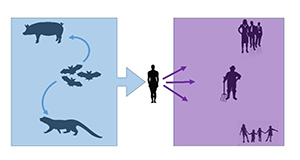Abstract
Bats make valuable contributions to natural ecosystems and provide benefits to people. We explain below how some unusual physical adaptations allow bats to harbor viruses that cause no harm to themselves but cause grave illness in humans. Transmission of these pathogens from bats to humans can occur only when humans have close interactions with bats and contact with their bodily fluids. A number of strategies could reduce the likelihood of bat viruses crossing over to humans, such as restrictions on harvesting of bats as bushmeat, curtailment of live wildlife markets, enforcement of regulations on illegal wildlife trade, and limiting deforestation and cave vandalism to reduce movement of bats into close proximity to humans. Enhancing efforts to protect bat roosts can reduce the likelihood of future zoonotic disease pandemics while also increasing the natural pest reduction services bats provide as they consume insects that cause damage to agronomic crops. Protecting bat roosts can also benefit human health by ensuring bats continue to consume mosquitos responsible for transmitting diseases such as Zika, Dengue, Malaria, and Chikungunya.
Unless otherwise specified, articles published in the EDIS journal after January 1, 2024 are licensed under a Creative Commons Attribution-NonCommercial-NoDerivs 4.0 International (CC BY-NC-ND 4.0) license.

